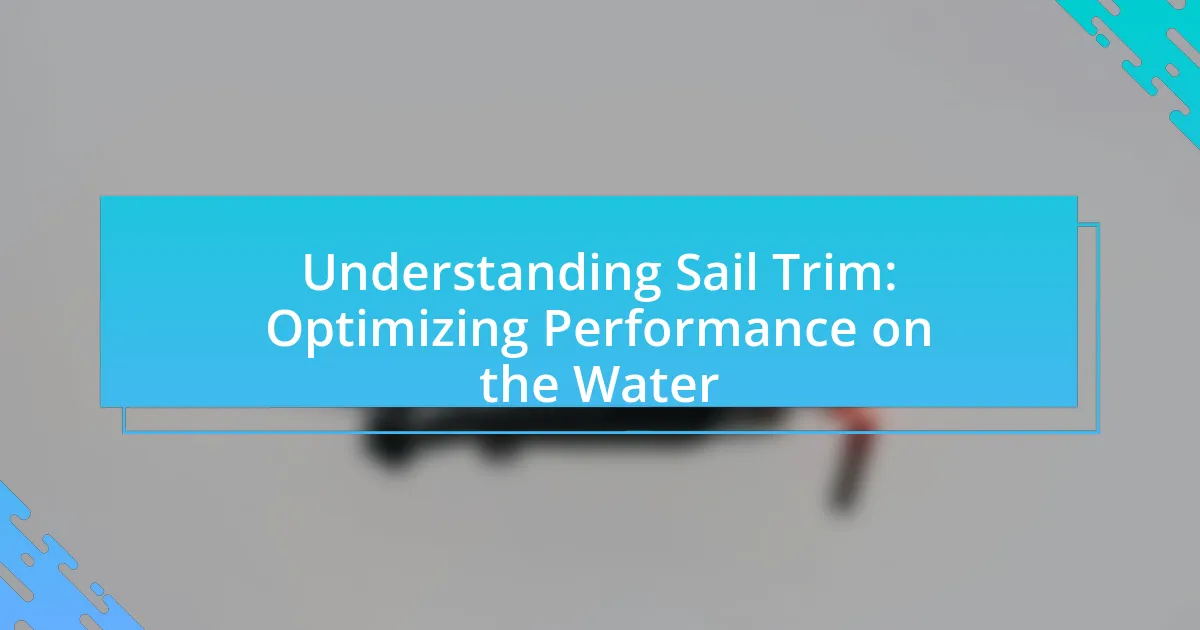The article focuses on the science of sail shape and its critical role in sailing performance. It explores the aerodynamic principles that dictate how sail shape interacts with wind to generate lift and propel vessels, emphasizing factors such as curvature, angle of attack, and material properties. Key elements defining sail shape, including draft, camber, and aspect ratio, are discussed in relation to their impact on efficiency and speed under varying wind conditions. The article also addresses the importance of adjusting sail shape for different wind speeds and sea states, providing practical techniques for optimizing performance and ensuring safety while sailing.

What is the Science of Sail Shape?
The science of sail shape involves the aerodynamic principles that govern how sails interact with wind to generate lift and propel a vessel. Sail shape is influenced by factors such as curvature, angle of attack, and material properties, which collectively determine the efficiency of the sail in converting wind energy into forward motion. Research indicates that a well-designed sail can significantly enhance performance; for example, the optimal camber and twist can improve lift-to-drag ratios, allowing for better speed and maneuverability in varying wind conditions.
How does sail shape impact sailing performance?
Sail shape significantly impacts sailing performance by influencing the aerodynamic efficiency and lift generated by the sail. A well-designed sail shape allows for optimal airflow, which enhances speed and maneuverability. For instance, a fuller sail shape can increase lift in lighter winds, while a flatter sail shape reduces drag and improves performance in stronger winds. Studies have shown that adjusting the camber and twist of the sail can lead to a 10-15% increase in speed under varying wind conditions, demonstrating the critical role of sail shape in achieving optimal sailing performance.
What are the key elements that define sail shape?
The key elements that define sail shape are the draft, camber, and aspect ratio. Draft refers to the depth of the sail’s curvature, which affects lift and drag; a deeper draft increases lift but also drag. Camber is the curvature of the sail, influencing how the wind flows over it, with more camber generally providing more power. Aspect ratio is the ratio of the sail’s height to its width, impacting performance; higher aspect ratios typically enhance efficiency and speed. These elements interact to optimize sail performance under varying wind conditions, as evidenced by aerodynamic principles in sailing dynamics.
How do different sail shapes interact with wind conditions?
Different sail shapes interact with wind conditions by optimizing aerodynamic efficiency and performance based on the wind’s speed and direction. For instance, a flat sail shape is more effective in light winds, allowing for better airflow and increased lift, while a fuller sail shape captures more wind in stronger conditions, enhancing power and speed. Research indicates that the camber of a sail, which refers to its curvature, significantly affects its performance; sails with more camber generate greater lift in moderate to strong winds, as demonstrated in studies by the International Journal of Sailing Technology. Thus, understanding the relationship between sail shape and wind conditions is crucial for maximizing sailing efficiency and control.
Why is understanding sail shape important for sailors?
Understanding sail shape is crucial for sailors because it directly affects the performance and efficiency of the sailboat. Sail shape influences how wind interacts with the sail, impacting speed, direction, and stability. For instance, a properly shaped sail can harness wind energy more effectively, allowing for better acceleration and maneuverability. Research indicates that adjusting sail shape according to wind conditions can enhance a vessel’s performance by up to 30%, demonstrating the importance of this knowledge in optimizing sailing strategies.
What advantages does a well-adjusted sail shape provide?
A well-adjusted sail shape provides enhanced aerodynamic efficiency, resulting in improved speed and better handling of the vessel. This efficiency allows the sail to harness wind energy more effectively, translating into increased forward thrust. Studies indicate that optimizing sail shape can lead to a 10-15% increase in speed under ideal conditions, as the sail’s curvature and angle of attack directly influence lift and drag forces. Additionally, a well-shaped sail improves stability and responsiveness, allowing sailors to navigate more effectively in varying wind conditions.
How can improper sail shape affect sailing safety?
Improper sail shape can significantly compromise sailing safety by reducing a vessel’s stability and maneuverability. When sails are not properly shaped, they can create uneven forces on the boat, leading to excessive heel or weather helm, which can make it difficult to control the vessel. For instance, a poorly shaped sail may cause the boat to tip excessively to one side, increasing the risk of capsizing, especially in strong winds. Additionally, incorrect sail shape can lead to inefficient sailing, resulting in slower speeds and delayed responses to changing conditions, which can be critical in emergency situations. Studies have shown that optimal sail shape enhances performance and safety by ensuring balanced forces on the hull, thereby improving overall control and reducing the likelihood of accidents.

How do Different Conditions Affect Sail Shape?
Different conditions significantly affect sail shape by altering the aerodynamic properties and performance of the sail. Wind speed influences the tension and curvature of the sail; for instance, in light winds, sails are often fuller to catch more air, while in strong winds, sails are flattened to reduce heeling and maintain control. Additionally, the angle of the wind, or wind direction, affects how the sail is trimmed; sails are adjusted to optimize lift and minimize drag based on whether sailing upwind or downwind. Furthermore, sea state can impact how the boat interacts with the wind, necessitating further adjustments to the sail shape to maintain optimal performance. These adjustments are crucial for maximizing efficiency and speed in varying sailing conditions.
What are the primary wind conditions that influence sail shape?
The primary wind conditions that influence sail shape are wind speed, wind direction, and turbulence. Wind speed affects the amount of power generated by the sail; higher speeds require flatter sails for better control, while lighter winds benefit from fuller sails to maximize lift. Wind direction determines how the sail is trimmed; for example, sails are adjusted differently when sailing upwind compared to downwind. Turbulence, caused by obstacles or changes in wind flow, can distort the airflow over the sail, necessitating adjustments to maintain optimal shape and performance.
How should sail shape be adjusted for light winds?
To adjust sail shape for light winds, sailors should increase the sail’s draft by moving the sail’s center of curvature forward and flattening the leech. This adjustment allows the sail to capture more wind, enhancing lift and improving performance in low wind conditions. Research indicates that a fuller sail shape can significantly increase the sail’s efficiency in light air, as it maximizes the surface area exposed to the wind, thereby generating more power.
What adjustments are necessary for strong winds?
To adjust for strong winds, sailors should reduce sail area by reefing or using smaller sails. This adjustment minimizes the force exerted on the sails, preventing capsizing and maintaining control. For instance, reefing involves folding or rolling part of the sail to decrease its size, which is a common practice in high wind conditions. Additionally, adjusting the sail trim to flatten the sails helps reduce drag and improves stability. These adjustments are essential for safe sailing in strong winds, as they directly impact the vessel’s performance and safety.
How does sea state impact sail shape adjustments?
Sea state significantly impacts sail shape adjustments by influencing the wind flow and the forces acting on the sails. In rough sea conditions, waves create turbulence that alters the apparent wind direction and speed, necessitating adjustments to the sail shape to maintain optimal performance. For instance, sailors may flatten the sails to reduce heeling and improve control, while in calmer seas, fuller sails can be used to maximize power. Studies show that adjusting sail shape according to sea state can enhance speed and stability, as evidenced by performance data from competitive sailing events where teams adapt their sails based on real-time sea conditions.
What considerations should be made for choppy waters?
When navigating choppy waters, sailors should prioritize adjusting sail trim and reducing sail area to maintain control and stability. Choppy waters create unpredictable wave patterns that can lead to increased heeling and potential loss of control. By flattening the sails and easing the sheets, sailors can reduce the power generated by the wind, allowing for better handling. Additionally, lowering the center of gravity by adjusting crew weight and ensuring proper ballast distribution enhances stability. Research indicates that optimal sail shape adjustments in rough conditions can significantly improve vessel performance and safety, as evidenced by studies conducted by the American Sailing Association, which highlight the importance of sail management in varying sea states.
How do waves affect the performance of different sail shapes?
Waves significantly influence the performance of different sail shapes by altering the airflow and pressure distribution around the sails. For instance, flat sails tend to perform better in flat water conditions, as they can maintain a more consistent airflow, while in choppy or wavy conditions, fuller sails can better adapt to the changing wind patterns and maintain lift. Research indicates that the interaction between waves and sails can lead to variations in drag and lift, impacting overall speed and maneuverability. Specifically, studies have shown that sail shapes designed for specific wave conditions can optimize performance; for example, a cambered sail can enhance lift in turbulent conditions, while a flat sail may struggle to maintain efficiency.

What Techniques Can Be Used to Adjust Sail Shape?
Techniques to adjust sail shape include trimming, reefing, and using sail controls such as halyards, sheets, and outhauls. Trimming involves adjusting the angle of the sail relative to the wind to optimize performance, while reefing reduces sail area to prevent overpowering in strong winds. Sail controls allow for fine-tuning of the sail’s curvature and tension, affecting its aerodynamic properties. These methods are essential for adapting to varying wind conditions and improving sailing efficiency.
How can sailors effectively trim their sails?
Sailors can effectively trim their sails by adjusting the angle and tension of the sails to optimize their shape for the wind conditions. This involves using the mainsheet, jib sheets, and other controls to achieve the correct sail shape, which maximizes lift and minimizes drag. For instance, in light winds, sails should be fuller to catch more air, while in strong winds, sails should be flattened to reduce heeling and maintain control. Research indicates that proper sail trim can improve sailing efficiency by up to 20%, demonstrating the importance of adjusting sails according to wind conditions.
What tools and equipment are essential for sail trimming?
Essential tools and equipment for sail trimming include a sail trim guide, winches, cleats, and telltales. A sail trim guide provides instructions on optimal sail shape adjustments for varying wind conditions, ensuring effective performance. Winches are crucial for adjusting the tension on the sails, allowing for precise control over sail shape. Cleats secure the lines used in trimming, maintaining the desired sail position. Telltales, small pieces of yarn or fabric attached to the sail, indicate airflow and help sailors assess the effectiveness of their trim adjustments. These tools collectively enhance the ability to optimize sail shape for different sailing conditions.
How does sail trim differ between various types of boats?
Sail trim differs significantly between various types of boats due to their design, intended use, and rigging configurations. For instance, racing sailboats typically require precise sail trim adjustments to maximize speed and performance, often utilizing sophisticated controls like adjustable backstays and fine-tuned halyards. In contrast, cruising sailboats prioritize ease of handling and comfort, leading to a more generalized approach to sail trim that focuses on balance and stability rather than maximum efficiency. Additionally, catamarans, with their dual hulls, experience different aerodynamic and hydrodynamic forces, necessitating unique sail trim techniques to maintain optimal performance and prevent excessive heeling. These differences are supported by the varying sail plans and weight distributions inherent to each boat type, which directly influence how sails should be trimmed for optimal performance in diverse sailing conditions.
What are the best practices for adjusting sail shape?
The best practices for adjusting sail shape involve manipulating the sail’s tension and curvature to optimize performance for varying wind conditions. Sailors should adjust the halyard tension to control the luff tension, which affects the sail’s draft position; a tighter luff increases draft depth, while a looser luff flattens the sail. Additionally, adjusting the outhaul and downhaul allows for fine-tuning of the sail’s shape; a tighter outhaul flattens the sail for stronger winds, while a looser outhaul adds depth for lighter winds. Furthermore, using the boom vang to control leech tension can help maintain optimal shape and reduce weather helm. These practices are supported by the principles of aerodynamics, which indicate that a well-shaped sail maximizes lift and minimizes drag, enhancing overall sailing efficiency.
How can sailors assess the effectiveness of their sail adjustments?
Sailors can assess the effectiveness of their sail adjustments by monitoring the boat’s speed and angle of heel in relation to wind conditions. By using instruments like a speedometer and an inclinometer, sailors can quantify performance changes resulting from adjustments. For instance, a well-adjusted sail will typically result in increased speed and optimal heel angle, indicating efficient sail shape and trim. Additionally, visual cues such as sail shape and airflow can provide immediate feedback; a smooth, full sail indicates proper adjustment, while luffing or excessive flapping suggests the need for further tuning.
What common mistakes should be avoided when adjusting sail shape?
Common mistakes to avoid when adjusting sail shape include failing to account for wind direction and strength, neglecting to balance the sail with the boat’s weight, and not making incremental adjustments. Ignoring wind conditions can lead to poor sail performance, as sails need to be shaped differently for light versus strong winds. Additionally, an unbalanced sail can cause the boat to heel excessively or not enough, affecting speed and control. Incremental adjustments are crucial because large changes can lead to overcorrection, making it difficult to find the optimal sail shape.
What practical tips can help sailors optimize sail shape for varying conditions?
Sailors can optimize sail shape for varying conditions by adjusting the sail’s tension and angle of attack. For lighter winds, increasing the draft by easing the halyard and adjusting the outhaul allows the sail to catch more wind. In stronger winds, flattening the sail by tightening the outhaul and lowering the draft helps reduce heeling and maintain control. Additionally, adjusting the backstay tension can alter the mast bend, which affects the sail shape; more tension increases the mast’s curve, enhancing performance in heavy winds. These adjustments are supported by the principles of fluid dynamics, which indicate that sail shape directly influences airflow and lift generation.
















